KTransformers Fine-Tuning × LLaMA-Factory Integration – Developer Technical Notes
MadSys Lab, KVCache-AI Team, Approaching AI, LLaMA-Factory Team
Introduction
Recent open-source LLMs—from DeepSeek-V3/R1 to Qwen-MoE and Kimi-K2—have surged in performance and scale. Yet due to compute and memory constraints, it is difficult for typical researchers to fine-tune trillion-parameter-class models. We therefore integrate KTransformers with LLaMA-Factory so that, with 2–4 RTX 4090 GPUs and sufficient CPU memory, one can fine-tune ultra-large Mixture-of-Experts (MoE) models such as DeepSeek-671B.
This architecture bridges resource gaps, enabling local fine-tuning of ultra-large models, while also supporting efficient scenario customization at 14B/30B scales. We validate on stylized dialogue, Westernized translation tone, and medical Q&A, achieving rapid adaptation within hours.
Architecturally, LLaMA-Factory orchestrates data/config/training, LoRA insertion, and inference; KTransformers is a pluggable, high-performance operator backend that takes over Attention and MoE under the same training code, enabling GPU+CPU heterogeneity to accelerate training and reduce GPU memory.
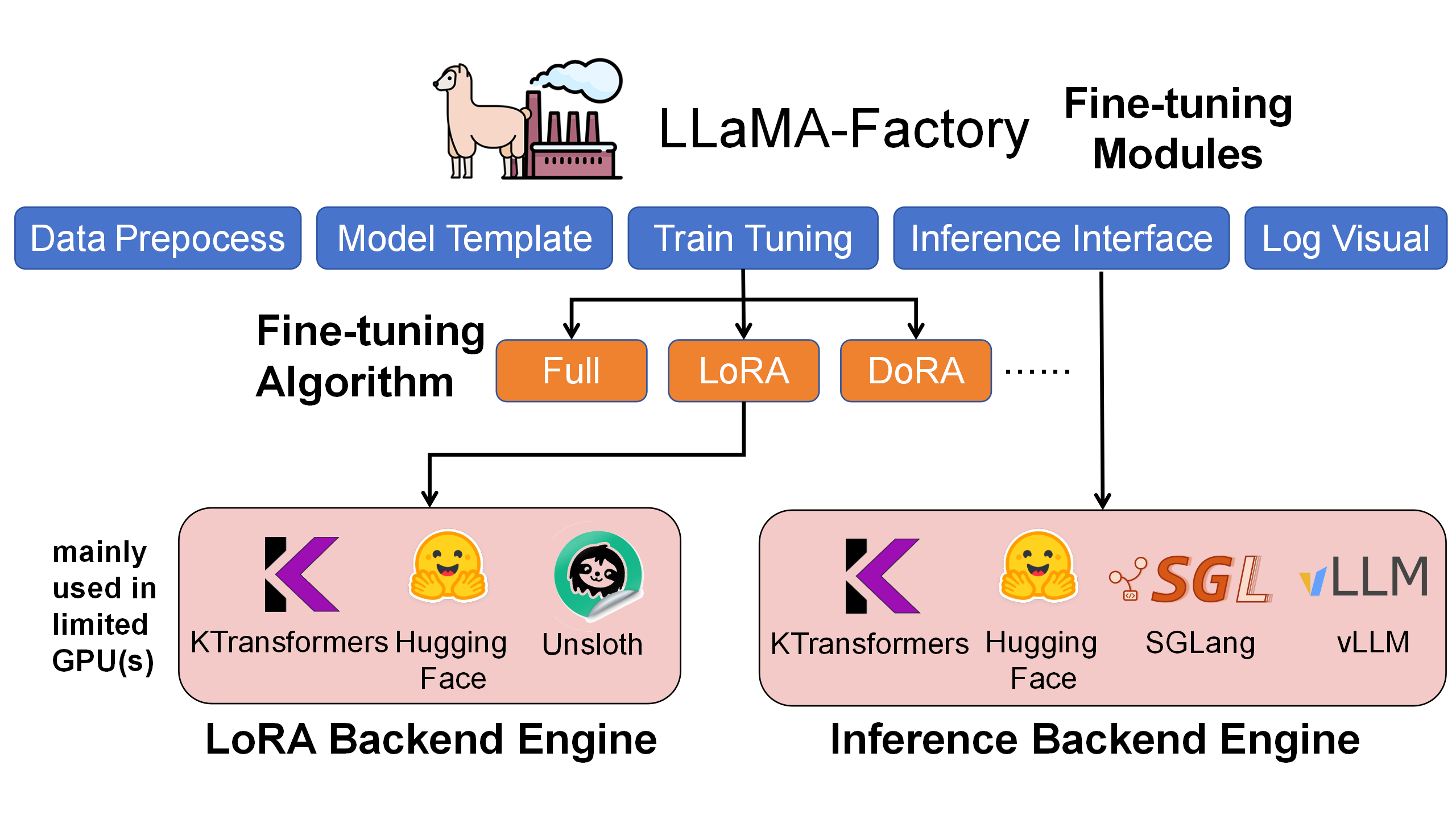
We evaluated LoRA fine-tuning with HuggingFace default, Unsloth, and KTransformers backends (same settings and data). KTransformers is currently the only solution feasible on 2–4×24GB 4090s for 671B-scale MoE, and also shows higher throughput and lower GPU memory for 14B MoEs.
| Under LoRA (BF16) + NekoQA-10K stylized dialogue | HuggingFace Backend | Unsloth Backend | KTransformers Backend |
|---|---|---|---|
| [14B-DeepSeekV2-Lite] LoRA fine-tuning throughput | 303.58 token/s | 455.37 token/s | 530.38 token/s |
| [14B-DeepSeekV2-Lite] GPU memory | 32.12 GB | 9.64 GB | 6.08 GB |
| [671B-DeepSeekV3] LoRA fine-tuning throughput | Too Huge to run | NOT SUPPORT | 40.35 token/s |
| [671B-DeepSeekV3] GPU memory (sum across GPUs) | theoretical 1400 GB † | NOT SUPPORT | 70 GB † |
† The 1400 GB is the theoretical FP16 full-resident footprint (not runnable). 70 GB is the measured peak with KT (Attention on GPU + layered MoE offload).
From the table above, it can be seen that for the 14B model, the KTransformers backend achieves approximately 75% higher throughput than the default HuggingFace solution, while using only about one-fifth of the GPU memory. For the 671B model, both HuggingFace and Unsloth fail to run on a single 4090 GPU, whereas KTransformers is able to perform LoRA fine-tuning at 40 tokens/s, keeping the GPU memory usage within 70 GB.

Overall View of the KT Fine-Tuning Framework
We detail how KTransformers takes over core operators in LLaMA-Factory’s fine-tuning framework to optimize Attention and MoE.
DeepSeek-V3/V2 MoE models comprise a small-parameter dense Attention part and a large-parameter sparse MoE part. For illustration, consider layer 2 of DeepSeek-V2-Lite-Chat (from which each layer includes both Attention and MoE). Attention compute and KV cache mainly reside on the GPU; the heavyweight MoE part is primarily executed on the CPU. We first cover Attention replacement and inheritance, then MoE encapsulation and backend interfacing, and finally multi-GPU placement.
Attention (LoRA + KT coexist)
KTransformers provides operator injection (BaseInjectedModule), and PEFT provides LoRA layer insertion. For fine-tuning, we design KTransformersLinearLora, inheriting from both KTransformersLinear and LoraLayer:
- Inheritance:
KTransformersLinearLoraretains KT’s high-performance paths (prefill_linear/generate_linear) while accepting LoRA parameters (lora_A/lora_B). - Replacement: During preparation, we replace original
KTransformersLinearlayers (Q/K/V/O) withKTransformersLinearLora, preserving KT optimizations while enabling LoRA trainability.
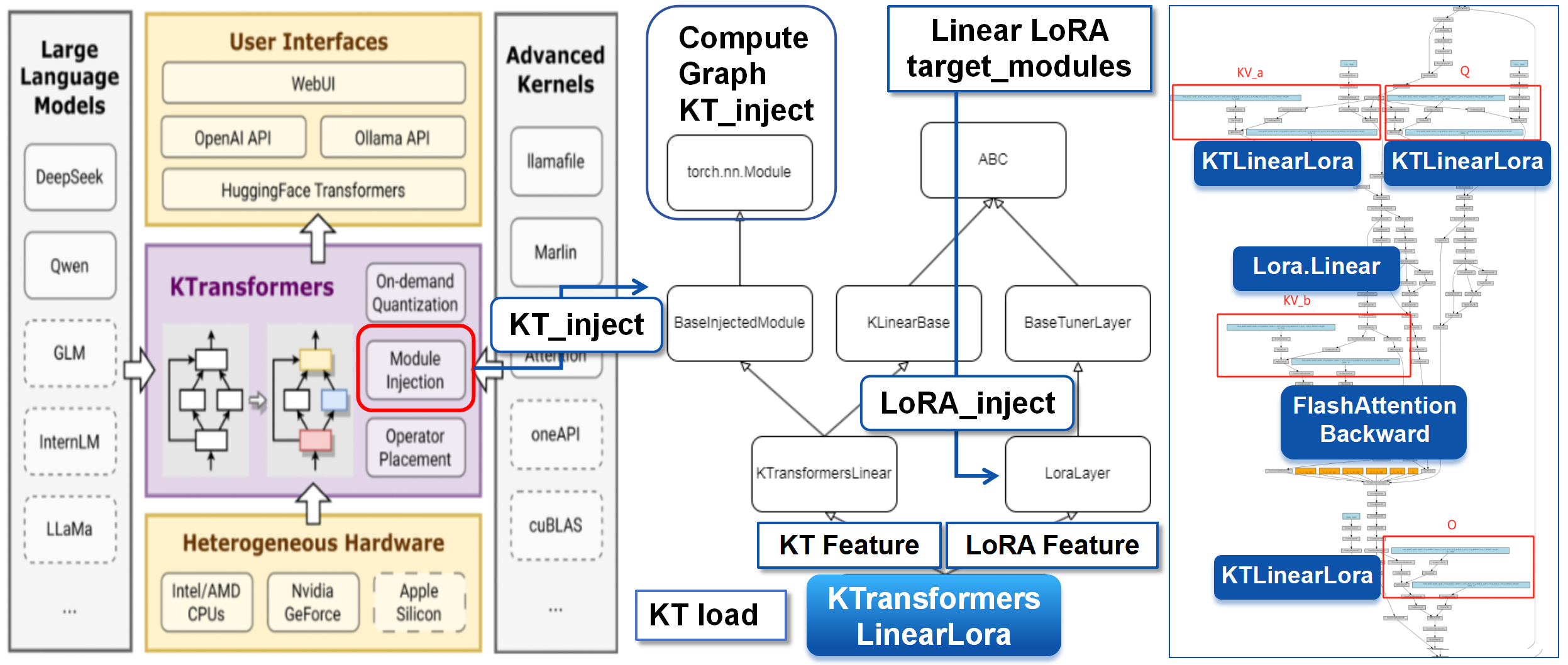
After replacement, LoRA is inserted at Q/K/V/O linear transforms (left), and KTransformersLinearLora contains both KT fast paths and LoRA matrices (right).
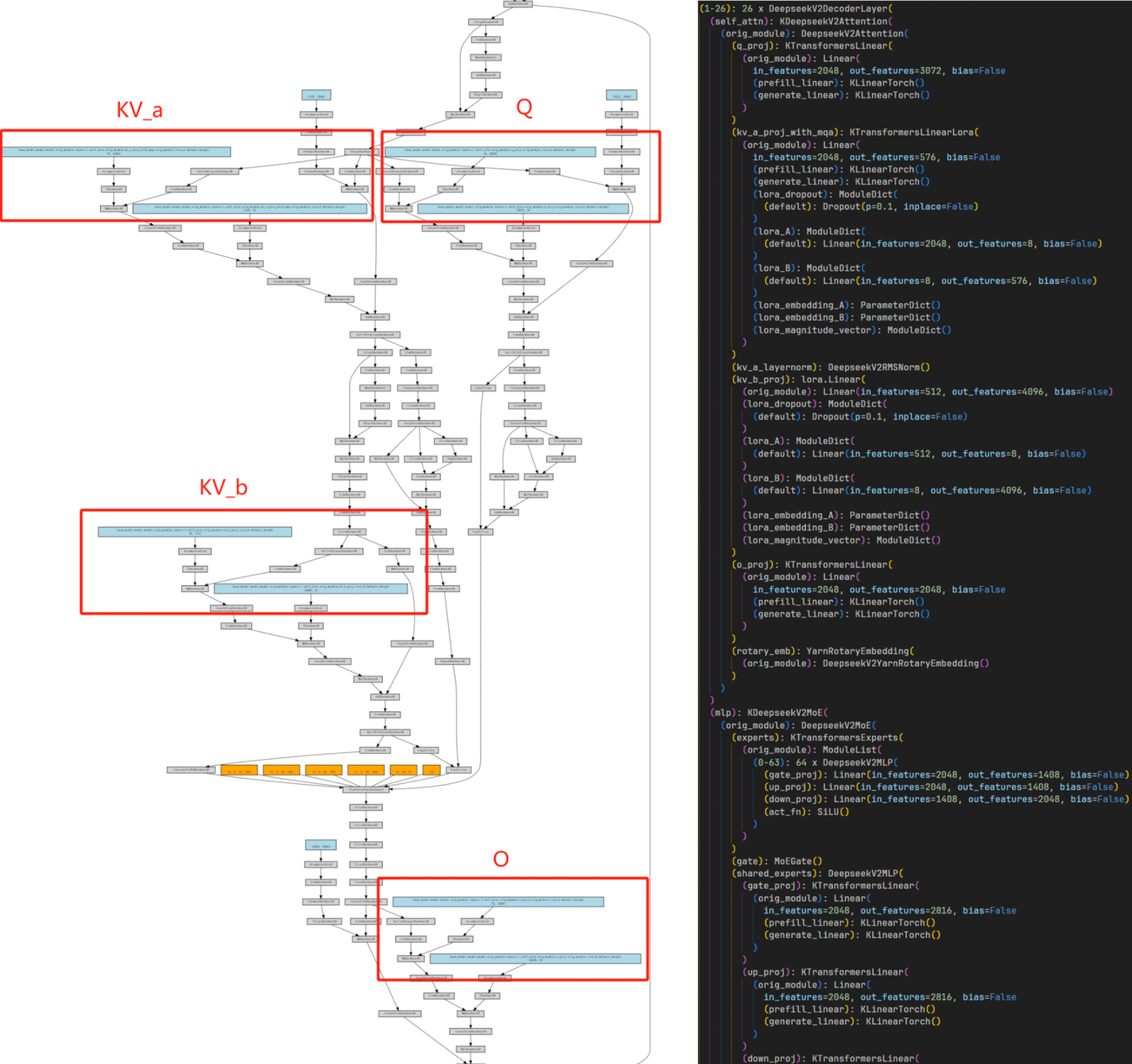
MoE (operator encapsulation + backward)
Encapsulation
Given large parameters and sparse compute, we encapsulate the expert computation as a differentiable black-box operator—transparent upstream, replaceable downstream.
- Upstream (PyTorch graph): we register a custom Autograd Function so the MoE layer appears as a single node. In the left figure (red box), only
KSFTExpertsCPUis visible; on the right, the unencapsulated graph expands routing, dispatch, and FFN experts. Encapsulation makes the MoE layer behave like a standardnn.Modulewith gradients. - Downstream (backend): inside the Autograd Function, pybind11 calls C++ extensions for forward/backward. Multiple pluggable backends exist (AMX BF16/INT8; llamafile). The backend can be switched via YAML (e.g.,
"backend": "AMXBF16"vs."llamafile").
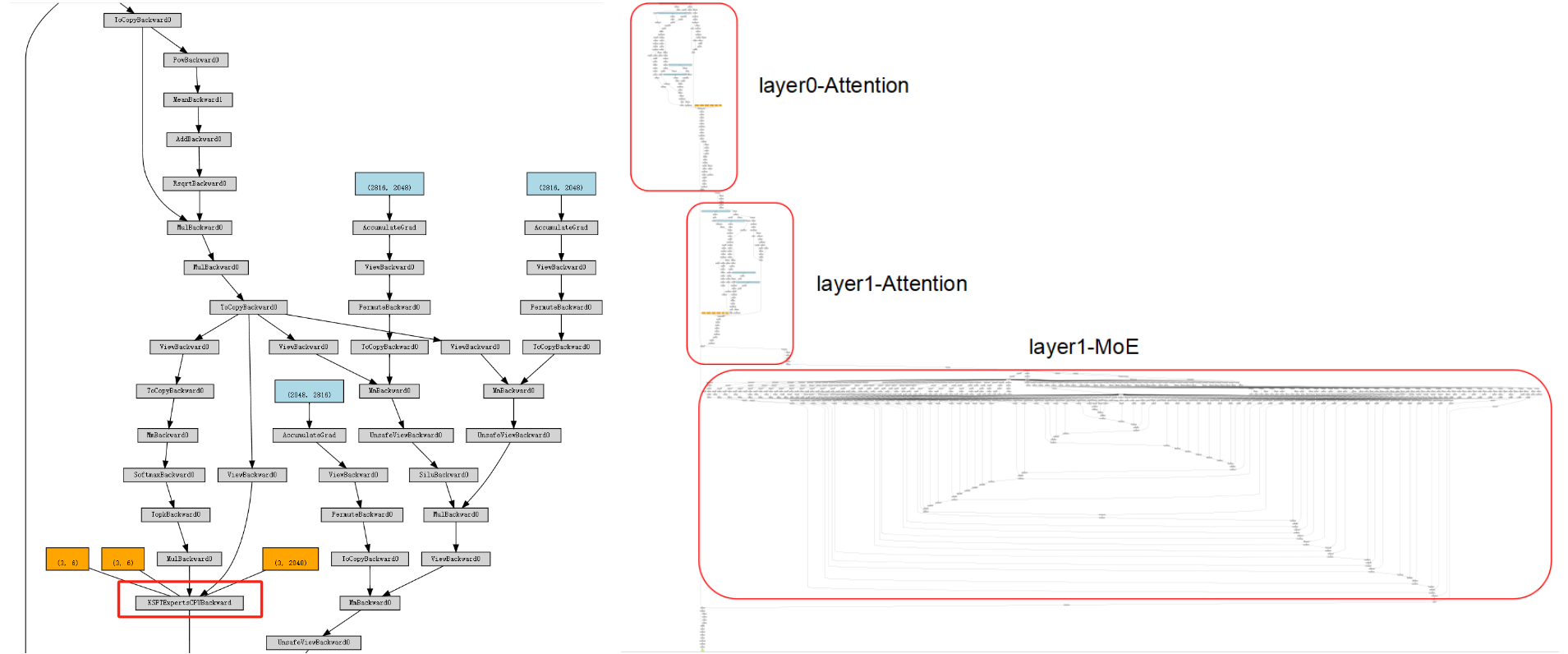
Backward (CPU)
MoE backward frequently needs the transposed weights $W^\top$. To avoid repeated runtime transposes, we precompute/cache $W^\top$ at load time (blue box). We also cache necessary intermediate activations (e.g., expert projections, red box) to reuse in backward and reduce recomputation. We provide backward implementations for llamafile and AMX (INT8/BF16), with NUMA-aware optimizations.

Multi-GPU Loading/Training: Placement strategy instead of DataParallel
To lower per-GPU memory peaks on 2–4 GPUs, we use model parallelism + explicit placement, not DataParallel (which duplicates the whole model on each GPU).
Key changes:
- KTrainer: takes over
.to(device)to prevent “move whole model to a single GPU”. Using KT’s optimize-rule YAML, each layer declaresdevice: cuda:0/cuda:1/...and is constructed directly on the target GPU (no extra copies). - Disable automatic DataParallel: when
USE_KT=1, we disable automatic DP wrappers from LLaMA-Factory/HF Trainer to avoid duplication and keep full control over sharding. - Gradient aggregation: gradients are reduced to
cuda:0. Intermediate activations stay local; only necessary tensors are transferred, cutting communication/activation overhead.
Thus, we keep KT placement strategies under multi-GPU fine-tuning. Users choose a kt_optimize_rule with multi-gpu. For DeepSeek-671B, DeepSeek-V3-Chat-sft-amx-multi-gpu.yaml is a typical 2-GPU plan: KV/attention parts on each GPU; MoE experts sharded on CPU; both GPUs share the workload.
KT-LoRA Fine-Tuning Evaluation
Setup
LLaMA-Factory orchestration, KTransformers backend, LoRA (rank=8, α=32, dropout=0.1, BF16), GAS=16, qlen=512, with the same KT optimize rule as training. We evaluate (a) stylized dialogue transfer and (b) two small-scale representative benchmarks: Translational-Style (generative) and AfriMed-QA (medical vertical; SAQ and MCQ). AMX is enabled; GPUs: 2×48GB RTX 4090; CPU: Intel Xeon Platinum 8488C.
Results
Stylized Dialogue (CatGirl tone)
Dataset: NekoQA-10K. The fine-tuned model consistently exhibits the target style (red boxes) versus neutral/rational base (blue). This shows KT-LoRA injects style features into the generation distribution with low GPU cost.
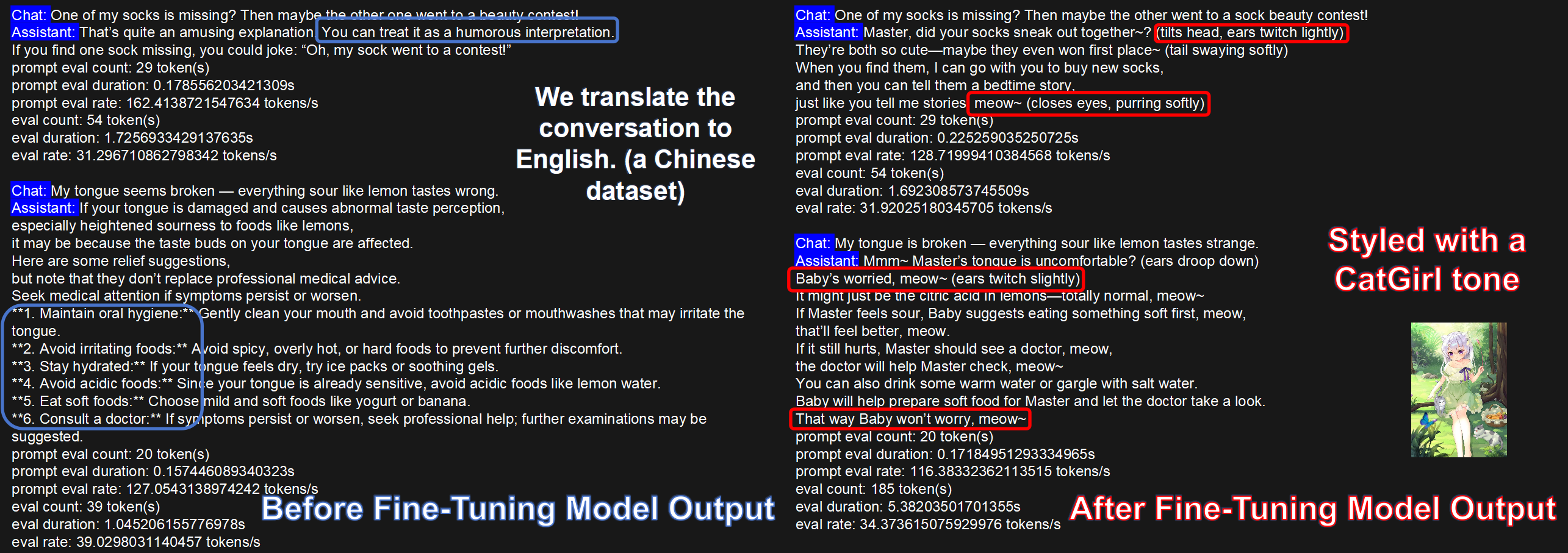
Translational-Style benchmark (generative)
Dataset: Translational-Style-ChatLLM. Metrics: BLEU-1/2/3/4, ROUGE-1/2/L.
| Translational-Style dataset | BLEU-1 | BLEU-2 | BLEU-3 | BLEU-4 | ROUGE-1 | ROUGE-2 | ROUGE-L |
|---|---|---|---|---|---|---|---|
| V2-Lite (no LoRA) | 20.66 | 8.33 | 4.54 | 2.89 | 22.71 | 4.52 | 19.19 |
| KT-LoRA fine-tuned V2-Lite | 35.41 | 22.44 | 15.42 | 11.18 | 42.03 | 18.38 | 33.10 |
| V3 base (no LoRA) | 8.49 | 3.34 | 1.62 | 0.96 | 15.91 | 2.55 | 10.07 |
| KT-LoRA fine-tuned V3 | 37.02 | 23.70 | 16.21 | 11.49 | 43.43 | 18.96 | 34.54 |
As shown by the test results in the tables above, under a unified workflow and placement strategy, both model scales exhibit consistent gains after fine-tuning, supporting the usability and effectiveness of the “KT backend + LoRA fine-tuning” combination for generative style control. At the same time, this indicates that KT’s heterogeneous placement and operator optimizations can stably support small-sample adaptation in the style domain.
Medical Vertical Benchmark (AfriMed-SAQ/MCQ)
The dataset adopts AfriMed-QA (ACL 2025), a domain-specific dataset for the medical field in Africa with strong scenario customization characteristics, comprising two formats—multiple-choice questions (MCQ) and short-answer questions (SAQ)—which in this case serve as the evaluation for vertical-domain fine-tuning. In terms of evaluation criteria, BLEU/ROUGE are used for SAQ, and Accuracy is used for MCQ.
| AfriMed-QA (SAQ) | BLEU-1 | BLEU-2 | BLEU-3 | BLEU-4 | ROUGE-1 | ROUGE-2 | ROUGE-L |
|---|---|---|---|---|---|---|---|
| V2-Lite (no LoRA) | 13.58 | 11.12 | 9.10 | 7.23 | 22.48 | 7.81 | 11.73 |
| KT-LoRA fine-tuned V2-Lite | 35.90 | 27.63 | 22.99 | 19.15 | 35.25 | 17.50 | 28.44 |
| V3 base (no LoRA) | 12.75 | 10.27 | 8.05 | 5.99 | 20.33 | 5.65 | 10.11 |
| KT-LoRA fine-tuned V3 | 42.42 | 34.12 | 28.95 | 24.54 | 41.97 | 22.37 | 33.28 |
| AfriMed-QA (MCQ) | Accuracy |
|---|---|
| V2-Lite (no LoRA) | 0.0645 |
| KT-LoRA fine-tuned V2-Lite | 0.4812 |
| V3 base (no LoRA) | 0.5833 |
| KT-LoRA fine-tuned V3 | 0.7930 |
As shown in the tables above, (1) DeepSeek-V3 (671B) after KT-LoRA fine-tuning achieves clearly higher performance than the fine-tuned DeepSeek-V2-Lite (14B) on both MCQ and SAQ, and it also surpasses the V3 base model. Within our small-scale setting, this preliminarily indicates that KT-LoRA fine-tuning of ultra-large-parameter models has practical significance in vertical domains.
(2) Across both SAQ/MCQ sub-tasks, KT-LoRA delivers consistent gains, indicating that—with KT’s heterogeneous placement and backend operator support—LoRA fine-tuning can effectively inject the key knowledge points of vertical domains such as medicine into the model.
Limitations
At present, most of our testing is conducted on single datasets and at small scale (≤ 20k examples), with the goal of providing existence evidence of system effectiveness for KT-LoRA fine-tuning, rather than drawing generalized conclusions about algorithmic generalization or scaling laws. Our report primarily presents representative figures; to support stronger algorithmic claims, larger sample sizes, multi-lingual/multi-domain datasets, and multi-seed repeated experiments would be required—these are beyond the scope of this work.
We also warmly welcome everyone to join the open-source LLaMA-Factory KT fine-tuning project. If you have additional test results, we especially welcome you to record them in the shared spreadsheet below, and to include the corresponding kt_optimize_rule files, dataset examples, training/evaluation YAMLs, and detailed GPU-memory and CPU configurations for community reference and reproducibility~!
Speed Tests
End-to-End Performance
Definitions
step_time:time per optimization step (tensor movement + Attention + MoE + others).
tokens_per_step = GAS × qlen;token/s = tokens_per_step / step_time。 We use GAS=16, qlen=512 → tokens_per_step=8192.
Measured
| Model | step_time (s) | tokens/step | token/s |
|---|---|---|---|
| DeepSeek-V3-671B | 203 | 8192 | 40.35 |
| DeepSeek-V2-Lite-14B | 36 | 8192 | 227.6 |
MoE Compute (DeepSeek-V3-671B)
Theory
- MoE per-layer, per-token FLOPs (forward+backward) approx.: $$ \text{FLOPs}_{\text{per-layer, per-token}} \approx c \cdot k \cdot H \cdot I $$
with $k = 8$(Top-k),$H = 7168$(hidden size),$I = 2048$(intermediate size),$c\approx16$(≈6 forward + ≈10 backward matmuls)。
- Per-step across all MoE layers: $$ \text{FLOPs}{\text{per-step}} \approx c \cdot qlen \cdot k \cdot H \cdot I \cdot L{\text{MoE}} $$
Plugging $c=16, qlen=512, k=8, H=7168, I=2048, L_{MoE}=58$,$\text{FLOPs}_{\text{per-step}} \approx 55.8\ \text{TFLOPs}$.
Measured (MoE TFLOPS on CPU)
If the MoE-only time per step is t_moe (seconds), $\text{TFLOPS} = \text{FLOPs}_{\text{per-step}} / \text{step_per_second}.$
Use MoE-phase time, not full step_time, to get MoE throughput.
| TFLOPS | Forward | Backward |
|---|---|---|
| Average | 17.55 | 18.41 |
Memory Footprint
- DeepSeek-V3 (671B; 58 MoE layers out of 61): ~70 GB total GPU, ~1.2–1.3 TB host memory.
- DeepSeek-V2-Lite (14B; 26 MoE layers out of 27): ~5 GB GPU, ~30 GB host memory.
Conclusion
Integrating KTransformers LoRA with LLaMA-Factory provides a practical path to efficiently train and deploy MoE LLMs. KT contributes placement strategies and operator optimizations (DeepSeek/Qwen/Kimi support with AMX-accelerated kernels), and LoRA enables customization with very low GPU memory; LLaMA-Factory supplies a coherent user-level interface.
This means even tens-to-hundreds-of-billion-parameter MoE models can be fine-tuned and served with low latency on ordinary hardware. The approach balances memory savings, speed, and usability, turning ultra-large models into tools that developers can actually wield.